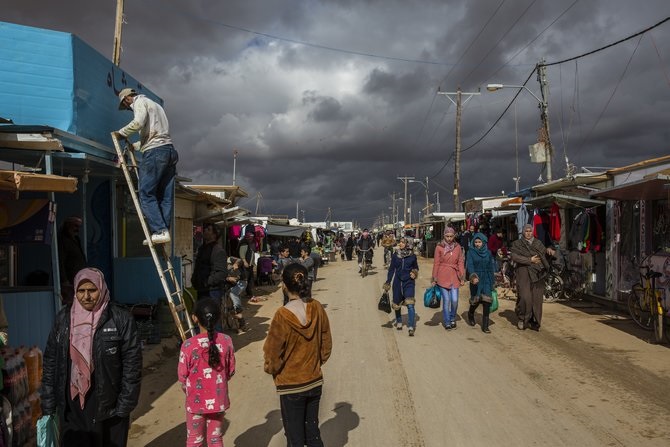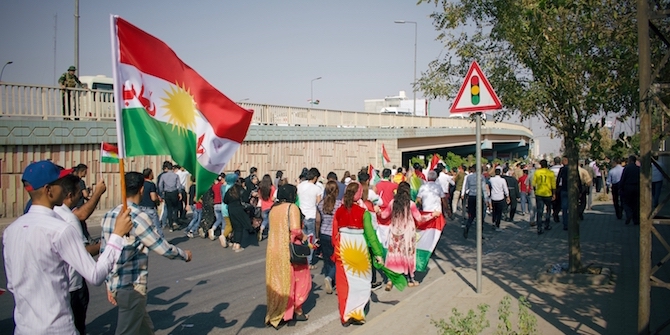by Lewis Turner

The Jordan Compact was meant to be a “new paradigm” for a refugee response. In bringing together humanitarian and development approaches, it aimed to turn “the Syrian refugee crisis into a development opportunity” – to provide jobs for Syrian refugees in Jordan and to aid the development of the Jordanian economy, benefiting refugees and host communities alike. But three years on, we can clearly see the challenges it has encountered, many of which are centred on questions of gender.
The Compact envisaged that by now 200,000 Syrians would be working legally (i.e. with work permits) in Jordan. The latest figures show that in fact 135,000 permits have been issued since early 2016, most of them for a period of 12 months. Therefore, this figure of 135,000 tells us nothing about the number of Syrians who currently have work permits or jobs, and will include several permits that went to the same individuals. Current figures are harder to come by, although last August, for example, only around 40,000 Syrian refugees in Jordan held valid work permits. Compared to expectations then, the numbers have been low.
According to Syrians who hold work permits, the main benefit they derive from the latter is a more secure legal status, and less fear of arrest and deportation. While this added security is important, Syrians’ working conditions have otherwise changed very little. In the quest to ensure they hold work permits, the agenda to secure decent work has been lost. Through a predominant focus on the scheme’s targets, its underlying goals have been side-lined.
The gender distribution of these permits has been a source of controversy since the beginning of the Compact. Some organisations working on the refugee response proposed that the release and allocation of donor funds should not merely be based on the overall number of work permits issued, and must also take into consideration the proportion of permits issued to Syrian women. While this particular proposal was widely rejected by some organisations, for different reasons, there has still been sustained interest, at least on a rhetorical level, in increasing the number of work permits for women.
Yet, figures that are released regularly by the Livelihoods Working Group show that Syrian women typically hold about 5 percent of the work permits issued to Syrians. The reasons for this are varied and complex. One of the main reasons why many Syrian women are not conducting work in the paid labour market is due to their engagement in domestic work already, namely childcare and housework. Other reasons cited by Syrian women include: a lack of opportunities to work in specific sectors, no interest in working, and a preference for doing paid labour from home. In light of this last reason, the recent government regulation that opens up the possibility of Syrians running home-based businesses in certain sectors might be seen as a positive development. At the same time, however, these attempts to regulate informal home-based businesses, and to channel relevant donor funds to Jordanians as well, may have “adverse effects on the livelihood of Syrian refugee families.”
At the same time, my PhD research indicates that many humanitarian actors assume Syrian women really want to do paid work outside the home (even if they say they do not), or at least that they should want to. If humanitarian actors want to respect Syrian women’s preferences, their focus surely has to be on finding ways to provide paid labour market opportunities for Syrian women who want them (whether inside or outside the home), without imposing an agenda that claims they should want them. That is to say, in discussions on ways to facilitate Syrian women’s labour market participation, Syrian women’s voices should be centred. Unfortunately, this has not been typically the case so far.
As Katharina Lenner and I have explored in depth, at the beginning of the Compact, there was a major pilot project that attempted to get Syrian women to work in the garment sector, which is one of Jordan’s most successful export sectors. Yet this pilot project failed, with only 30 women employed by the end of 2016, rather than the envisaged 2,000. One of the key reasons behind this failure was that Syrian women themselves mostly did not want to work in these factories. This was due to a variety of reasons, including the cost of transport, long distance to factories, lack of childcare facilities, poor wages, bad working conditions, and long hours. While humanitarian organisations are attempting to find new ways to facilitate Syrian women’s work in these factories (such as providing support for training and transport), we must also question whether facilitating Syrian women’s work in an exploitative labour regime should count as a ‘success’ or be a humanitarian target in the first place.
Another gender-related challenge is that Syrian refugees are, informally, often responsible for paying the necessary fees to get work permits. While there are few formal fees, informal fees, including payments to employers and brokers, can amount to $500. When faced with such high costs, many families have to make difficult choices, which include prioritising one family member for a work permit over others.
The fact that many Syrian families have prioritised men for these permits reflects prevailing understandings of gendered roles and responsibilities, but also reflects the fact that Syrian men are disproportionately likely to be perceived as a ‘security threat’, and disproportionately likely to face the risk of arrest, forced encampment, or deportation for working without a permit. These are some important factors that Syrian families take into account in their decisions regarding work permits, and therefore need to be integrated in humanitarian planning too.
The challenges that the Compact has faced, in terms of overall numbers and in relation to gender, have resulted in large part from the fact the refugees’ voices, as they so often are, have not been prioritised. If initiatives such as the Jordan Compact are going to succeed, the perspectives of refugees of all genders need to be taken seriously. Refugees’ voices should not merely be “included,” but centred. Refugees are the experts on their own lives.
 Lewis Turner is a Senior Researcher at the Arnold Bergstraesser Institute in Freiburg, Germany. His research focuses on the humanitarian response for Syrian refugees in Jordan, especially questions of gender (particularly men and masculinities), race, work, labour markets and encampment. His work has appeared in journals including Middle East Critique and Mediterranean Politics. He tweets at: @lewiseturner
Lewis Turner is a Senior Researcher at the Arnold Bergstraesser Institute in Freiburg, Germany. His research focuses on the humanitarian response for Syrian refugees in Jordan, especially questions of gender (particularly men and masculinities), race, work, labour markets and encampment. His work has appeared in journals including Middle East Critique and Mediterranean Politics. He tweets at: @lewiseturner
This post and others in the series are based on presentations held during a conference organised by the LSE Middle East Centre on 7–8 March 2019, titled ‘Between Institutional Resilience to the Syrian Refugee Crisis and the Resilience of Syrian Refugees’.
In this series:
- Questioning Dominant Refugee Narratives and Research Methodologies by Yasmine Kherfi
- Contested Meanings of Resilience Building: How Great Expectations in Brussels are Dashed in Beirut by Tamirace Fakhoury
- Between Vulnerability and Resilience – ‘Refugeeness’ as Political Subjectivity by Jouni Häkli and Kirsi Pauliina Kallio
- Resilience and Relationality: the Agency of Pious Syrian Refugee Women by Umut Ozkaleli
- Why Ethnography is Important for Refugee-related Research by Sarah A Tobin







5 Comments